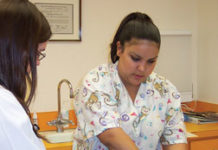Constipation and Dietary Help
Owners often bring their cats to the veterinarian due to a bout of constipation, which can have a variety of causes. Veterinary treatment includes determining and eliminating the cause, if possible, along with medical and sometimes surgical management. Medical therapy often includes the use of laxatives, enemas and prokinetic agents (like cisapride). Psyllium is a soluble fiber that produces a mucilaginous gel that helps to increase fecal bulk. It also adds to stool bulk by other water-holding properties. Psyllium has been found to increase stool frequency and consistency in humans with idiopathic constipation.
This study involved assessing the use of a highly digestible dry food formula, with added psyllium, in two field trials involving 66 cats with constipation (“Uncontrolled study assessing the impact of a psyllium-enriched dry diet on fecal consistency in cats with constipation,” Journal of Feline Medicine and Surgery, 2011).
The authors concluded from both trials that the test diet was palatable and well-accepted, clinical remission was noted in the majority of the patients, and that other symptomatic therapy was either not needed in clinical management or could often be discontinued or reduced without recurrence of clinical signs.
The authors also noted that both surgical management and euthanasia were being considered in a small number of cats, but were subsequently not required due to the success of dietary therapy.
Protein and Kidney Function
High dietary protein levels are very important for kittens during the growth phase, and are also considered beneficial for cats throughout all life stages. With more attention being paid to obesity and diabetes in cats in recent decades, there has also been a growing awareness of high protein (HP) diets in the management of both diseases. Meat is the major source of protein in HP diets and this contributes to increased intake of creatine and creatinine, which can result in increased serum creatinine concentrations.
This study evaluated the effect of dietary protein content on renal parameters in 23 healthy spayed female cats (“Effects of dietary protein content on renal parameters in normal cats,” Journal of Feline Medicine and Surgery, 2011). The objective was to determine if cats eating diets high in protein would have higher serum urea nitrogen (UN) and creatinine values without a detectable change in kidney function.
The cats were fed in two phases: in the first phase, they were randomly assigned either a (HP) or low protein diet. For the second phase, the cats were fed whichever diet they were not fed in the first phase. Blood and urine samples were collected every two weeks during the 10-week study period. The study results noted that dietary intake could result in statistically significant changes in UN and several other biochemical analytes, although all analytes stayed within normal reference intervals. This information illustrates a need to obtain an accurate dietary history in cat patients in order to account for dietary influences on renal parameters, especially UN.
Facial Dermatitis and Herpesvirus
Ulcerative dermatitis secondary to feline herpesvirus (FHV) infection is an uncommon disease that can sometimes resemble other cutaneous diseases, such as eosinophilic granuloma and mosquito bite hypersensitivity. The researchers compared two methods for diagnosis of FHV-associated dermatitis — polymerase chain reaction (PCR) for amplification and detection of viral genetic material and immunohistochemistry (IHC) for detection of viral protein (“Detection of feline herpes virus 1 via polymerase chain reaction and immunohistochemistry in cats with ulcerative facial dermatitis, eosinophilic granuloma complex reaction patterns and mosquito bite sensitivity,” Veterinary Dermatology, 2011).
Skin biopsy specimens from 62 cats with ulcerative skin lesions were tested by both methods. Immunohistochemistry for viral protein is considered the best form of diagnosis. PCR detected the presence of FHV genetic material in 12 samples, while IHC was positive in only two. Because of its high sensitivity and ability to detect latent or vaccinal virus, the authors concluded that PCR alone could result in misdiagnosis of FHV-associated dermatitis. They recommend PCR as an initial screening test, and, if positive, confirmation testing should be performed using IHC.



